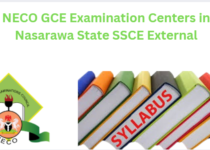NECO Areas Of For Further Mathematics 2025/2026
The NECO Areas of Concentration for Further Mathematics 2025/2026 have become a key resource for many students preparing for the NECO exam. Numerous candidates have visited our website seeking guidance on the syllabus to help them effectively prepare for the Further Mathematics examination. With growing interest, it is essential for students to access the most reliable and up-to-date information to aid their preparation.
We we have compiled everything needed regarding the NECO Areas of Concentration for Further Mathematics, providing a comprehensive guide to ensure candidates are fully prepared.
For those searching for answers to queries related to the NECO syllabus for Further Mathematics, Mathematics, Biology, Chemistry, Economics, and other subjects, this platform offers detailed information to help you succeed in the 2025/2026 NECO exams.
Contents
Pure Mathematics
- Sets
- Set notations, disjoint sets, Venn diagrams, De Morgan’s laws.
- Surds
- Simplification, rationalizing denominators, operations on surds.
- Binary Operations
- Closure, Commutativity, Associativity, Distributivity, Identity elements, Inverses.
- Logical Reasoning
- Syntax, truth tables, logical arguments, implications, and connectives.
- Functions
- Domain, co-domain, one-to-one, onto, composite, inverse, graphical representation.
- Polynomial Functions
- Linear, quadratic, cubic functions and equations, inequalities, graphing, and solving.
- Rational Functions
- Operations on rational functions, partial fractions, domain, range.
- Indices and Logarithms
- Laws of indices, solving equations, logarithmic properties, graphing.
- Permutation and Combinations
- Arrangements (nPr), selections (nCr), basic problems on arrangements and selections.
- Binomial Theorem
- Expansion for positive integral index, simple approximations.
- Sequences and Series
- Arithmetic Progression (A.P.), Geometric Progression (G.P.), recurrence series.
- Matrices and Linear Transformation
- Matrix operations, determinants, inverse of 2×2 matrices, linear transformations.
- Trigonometry
- Ratios, compound and multiple angles, trigonometric equations, graphing.
- Coordinate Geometry
- Straight lines, conic sections, distance, midpoint, equations of lines and circles.
- Differentiation
- Limits, derivatives, product/quotient rules, maxima/minima, implicit differentiation.
- Integration
- Indefinite and definite integrals, applications (area, volume, trapezium rule).
II. Statistics and Probability
- Statistics
- Data representation, measures of central tendency and dispersion, correlation, regression.
- Probability
- Probability basics, addition/multiplication rules, probability distributions (binomial, Poisson).
III. Vectors and Mechanics
- Vectors
- Scalar/vector quantities, vector operations, dot product, cross product, unit vectors.
- Statics
- Force representation, equilibrium, moments, friction, Lami’s theorem.
- Dynamics
- Motion, equations of motion, impulse, momentum, projectiles.
IV. Units and Currencies
- Units
- Length, area, capacity, mass, conversion of units.
- Currencies
- Conversion among different currencies (Ghana, Liberia, Nigeria, Sierra Leone, etc.).
This list covers key topics across pure mathematics, statistics, probability, vectors, mechanics, and relevant units and currency conversions.
Summary
The syllabus for this examination is designed to test candidates’ development of mathematical skills, including conceptual and manipulative abilities. It aims to enhance their understanding of an intermediate level of mathematics, bridging the gap between elementary and higher mathematics.
The syllabus also focuses on preparing candidates for careers in fields such as Mathematics, Engineering, and Science by fostering logical reasoning, abstract thinking, and the ability to analyze data and draw valid conclusions.
The examination consists of two papers: Paper 1 and Paper 2. Paper 1 includes forty multiple-choice objective questions, covering the entire syllabus. Candidates are required to answer all questions in one hour for a total of 40 marks.
The questions are distributed across three main areas: Pure Mathematics, Statistics and Probability, and Vectors and Mechanics. Paper 2 is divided into two sections, A and B, with Section A containing eight compulsory elementary questions for 48 marks, and Section B consisting of more challenging questions in three parts for 52 marks.
The use of mathematical and statistical tables is permitted in the exam, and candidates can also use non-programmable, silent calculators. However, calculators must not have any paper printout or communication capabilities, and phones are strictly prohibited.
Candidates are expected to bring essential tools such as rulers, compasses, protractors, and set squares, and they will be provided with graph paper when needed.


